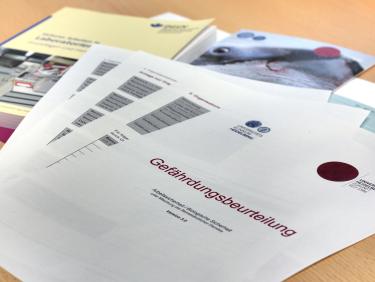Assessment of working conditions Risk assessment
The risk assessment (GefB) of workplaces is based on the Occupational Health and Safety Act and various occupational health and safety regulations (in particular the Ordinance on Biological Substances, Ordinance on Hazardous Substances, Ordinance on Industrial Safety and Health).
In addition to issues relating to the design of workplaces and the physical, chemical and biological effects on employees (technical hazards), there is also a need to investigate the design and selection of work equipment, work and production processes, work procedures and working hours and their interaction (mental stress).
To determine the technical hazards at the facilities of Heidelberg University and Heidelberg University Hospital, the Occupational Safety Department provides risk assessment documents that can be requested from the occupational safety specialists responsible for the individual facilities. The documents are regularly revised and updated and have been available in version 3.0 since 2022.
A risk assessment in a facility begins with a kick-off meeting initiated by the occupational safety department; the implementation of the entire measure is closely monitored by the responsible specialist.

First, the organisational structure of the institution (e.g. institute, seminar, clinic) is determined. All areas within this organisation are recorded (e.g. working groups, departments, wards, workshops), responsibilities are defined, persons for coordination and implementation are determined and the start and end dates of the assessment are recorded.
Then the organisation of occupational health and safety is checked. Are all the necessary functionaries (safety officers, first aiders, etc.) present? General and specific hazards are identified using checklists.
If existing hazards are not included, additional questions or lists can be created.
There are three columns in all checklists: yes, no and not applicable. All questions marked with no (=deficiencies) must be entered in the catalogue of measures and processed.
The signatures of those responsible for the individual areas of a facility are obtained once the risk assessment has been completed. Once all signatures have been obtained, the final signature is that of the head of the facility, who has overall responsibility for the implementation and details of the risk assessment.
The risk assessment must be repeated annually or if the the work processes are updated.
Particularly vulnerable groups of persons
Employers must take special hazards for ‘particularly vulnerable groups of employees’ into account when implementing occupational health and safety measures (Section 4 No. 6 ArbSchG). These include, e.g. young people, pregnant women, nursing mothers and disabled employees, as well as older employees.
Not only do special legal requirements apply to these groups of people (e.g. JArbSchG, MuSchG, ...), their special protection needs must also be taken into account in the risk assessment. According to Section 10 of the Maternity Protection Act, for example, every workplace must be assessed in advance with regard to potential hazards for expectant and nursing mothers.
Employment restrictions and prohibitions
Expectant and nursing mothers may only be exposed to hazardous substances under certain conditions. Working with carcinogenic, mutagenic or reprotoxic substances and with certain pathogens is generally not permitted.